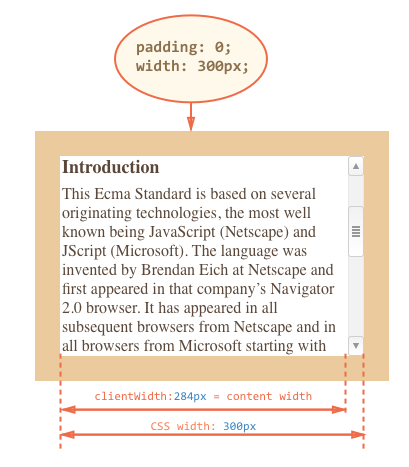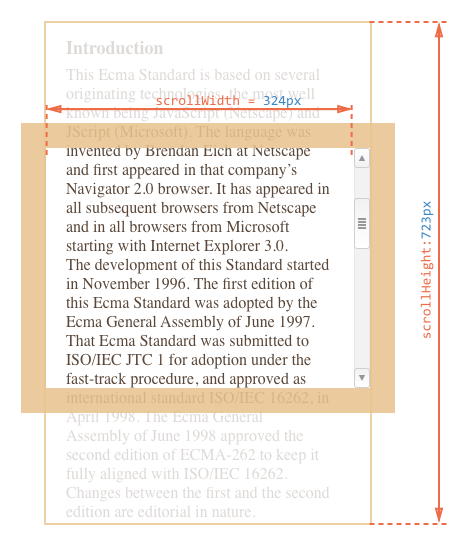12 KiB
Element size and scrolling
There are many JavaScript properties that allow to read information about element width, height and other geometry features.
We often need them when moving or positioning elements in JavaScript, to correctly calculate coordinates.
[cut]
Sample element
As a sample element to demonstrate properties we'll use the one given below:
<div id="example">
...Text...
</div>
<style>
#example {
width: 300px;
height: 200px;
border: 25px solid #E8C48F;
padding: 20px;
overflow: auto;
}
</style>
It has the border, padding and scrolling. The full set of features. There are no margins, as they are not the part of the element itself, and there are no special properties for them.
The element looks like this:
You can open the document in the sandbox.
The picture above demonstrates the most complex case when the element has a scrollbar. Some browsers (not all) reserve the space for it by taking it from the content.
So, without scrollbar the content width would be `300px`, but if the scrollbar is `16px` wide (the width may vary between devices and browsers) then only `300-16 = 284px` remains, and we should take it into account. That's why examples from this chapter assume that there's a scrollbar. If there's no scrollbar, then things are just a bit simpler.
```smart header="The padding-bottom may be filled with text"
Usually paddings are shown empty on illustrations, but if there's a lot of text in the element and it overflows, then browsers show the "overflowing" text at padding-bottom, so you can see that in examples. But the padding is still there, unless specified otherwise.
## Geometry
Element properties that provide width, height and other geometry are always numbers. They are assumed to be in pixels.
Here's the overall picture:

They are many properties, it's difficult to fit them all in the single picture, but their values are simple and easy to understand.
Let's start exploring them from the outside of the element.
## offsetParent, offsetLeft/Top
These properties are rarely needed, but still they are the "most outer" geometry properties, so we'll start with them.
The `offsetParent` is the nearest ancestor that is:
1. CSS-positioned (`position` is `absolute`, `relative` or `fixed`),
2. or `<td>`, `<th>`, `<table>`,
2. or `<body>`.
In most practical cases we can use `offsetParent` to get the nearest CSS-positioned ancestor. And `offsetLeft/offsetTop` provide x/y coordinates relative to it's left-upper corner.
In the example below the inner `<div>` has `<main>` as `offsetParent` and `offsetLeft/offsetTop` are shifts from its left-upper corner (`180`):
```html run height=10
<main style="position: relative" id="main">
<article>
<div id="example" style="position: absolute; left: 180px; top: 180px">...</div>
</article>
</main>
<script>
alert(example.offsetParent.id); // main
alert(example.offsetLeft); // 180 (note: a number, not a string "180px")
alert(example.offsetTop); // 180
</script>
There are several occasions when offsetParent is null:
- For not shown elements (
display:noneor not in the document). - For
<body>and<html>. - For elements with
position:fixedon them.
offsetWidth/Height
Now let's move to the element itself.
These two properties are the simplest ones. They provide the "outer" width/height of the element. Or, in other words, its full size including borders.
For our sample element:
offsetWidth = 390-- the outer width, can be calculated as inner CSS-width (300px) plus paddings (2*20px) and borders (2*25px).offsetHeight = 290-- the outer height.
Geometry properties are calculated only for shown elements.
If an element (or any of its ancestors) has `display:none` or is not in the document, then all geometry properties are zero or `null` depending on what it is.
For example, `offsetParent` is `null`, and `offsetWidth`, `offsetHeight` are `0`.
We can use this to check if an element is hidden, like this:
```js
function isHidden(elem) {
return !elem.offsetWidth && !elem.offsetHeight;
}
```
Please note that such `isHidden` returns `true` for elements that are on-screen, but have zero sizes (like an empty `<div>`).
clientTop/Left
Inside the element we have the borders.
To measure them, there are properties clientTop and clientLeft.
In our example:
clientLeft = 25-- left border widthclientTop = 25-- top border width
...But to be precise -- they are not borders, but relative coordinates of the inner side from the outer side.
What's the difference?
It becomes visible when the document is right-to-left (the operation system is in arabic or hebrew languages). The scrollbar is then not on the right, but on the left, and then clientLeft also includes the scrollbar width.
In that case clientLeft in our example would be not 25, but with the scrollbar width 25+16=41:
clientWidth/Height
These properties provide the size of the area inside the element borders.
They include the content width together with paddings, but without the scrollbar:
On the picture above let's first consider clientHeight: it's easier to evaluate. There's no horizontal scrollbar, so it's exactly the sum of what's inside the borders: CSS-height 200px plus top and bottom paddings (2*20px) total 240px.
Now clientWidth -- here the content width is not 300px, but 284px, because 16px are occupied by the scrollbbar. So the sum is 284px plus left and right paddings, total 324px.
If there are no paddings, then clientWidth/Height is exactly the content area, inside the borders and the scrollbar (if any).
So when there's no padding we can use clientWidth/clientHeight to get the content area size.
scrollWidth/Height
- Properties
clientWidth/clientHeightonly account for the visible part of the element. - Properties
scrollWidth/scrollHeightalso include the scrolled out (hidden) part:
On the picture above:
scrollHeight = 723-- is the full inner height of the content area including the scrolled out part.scrollWidth = 324-- is the full inner width, here we have no horizontal scroll, so it equalsclientWidth.
We can use these properties to expand the element wide to its full width/height.
Like this:
// expand the element to the full content height
element.style.height = element.scrollHeight + 'px';
Click the button to expand the element:
<div id="element" style="width:300px;height:200px; padding: 0;overflow: auto; border:1px solid black;">text text text text text text text text text text text text text text text text text text text text text text text text text text text text text text text text text text text text text text text text text text text text text text text text text text text text text text text text text text text text text text text text text text text text text text text text text text text text text text text text text text text text text text text text text text text text text text text text text text text text text text text text text text text text text text text text text text text text text text text text text text text text text text text text text text text text text text text text text text text text</div>
<button style="padding:0" onclick="element.style.height = element.scrollHeight + 'px'">element.style.height = element.scrollHeight + 'px'</button>
scrollLeft/scrollTop
Properties scrollLeft/scrollTop are the width/height of the hidden, scrolled out part of the element.
On the picture below we can see scrollHeight and scrollTop for a block with a vertical scroll.
In other words, scrollTop is "how much is scrolled up".
````smart header="scrollLeft/scrollTop can be modified"
Most geometry properties that are read-only, but scrollLeft/scrollTop can be changed, and the browser will scroll the element.
If you click the element below, the code `elem.scrollTop+=10` executes. That makes the element content scroll `10px` below.
<div onclick="this.scrollTop+=10" style="cursor:pointer;border:1px solid black;width:100px;height:80px;overflow:auto">Click<br>Me<br>1<br>2<br>3<br>4<br>5<br>6<br>7<br>8<br>9</div>
Setting scrollTop to 0 or Infinity will make the element scroll to the very top/bottom respectively.
## Don't take width/height from CSS
We've just covered geometry properties of DOM elements. They are normally used to get widths, heights and calculate distances.
But as we know from the chapter <info:styles-and-classes>, we can read CSS-height and width using `getComputedStyle`.
So why not to read the width of an element like this?
```js run
let elem = document.body;
alert( getComputedStyle(elem).width ); // show CSS width for elem
```
Why we should use geometry properties instead? There are two reasons:
1. First, CSS width/height depend on another property: `box-sizing` that defines "what is" CSS width and height. A change in `box-sizing` for CSS purposes may break such JavaScript.
2. Second, CSS `width/height` may be `auto`, for instance for an inline element:
```html run
<span id="elem">Hello!</span>
<script>
*!*
alert( getComputedStyle(elem).width ); // auto
*/!*
</script>
```
From the CSS standpoint, `width:auto` is perfectly normal, but in JavaScript we need an exact size in `px` that we can use in calculations. So here CSS width is useless at all.
And there's one more reason: a scrollbar. Sometimes the code that works fine without a scrollbar starts to bug with it, because a scrollbar takes the space from the content in some browsers. So the real width available for the content is *less* than CSS width. And `clientWidth/clientHeight` take that into account.
...But with `getComputedStyle(elem).width` the situation is different. Some browsers (e.g. Chrome) return the real inner width, minus the scrollbar, and some of them (e.g. Firefox) -- CSS width (ignore the scrollbar). Such cross-browser differences is the reason not to use `getComputedStyle`, but rather rely on geometry propeties.
```online
If your browser reserves the space for a scrollbar (most browsers for Windows do), then you can test it below.
[iframe src="cssWidthScroll" link border=1]
The element with text has CSS `width:300px`.
On a Desktop Windows OS, Firefox, Chrome, Edge all reserve the space for the scrollbar. But Firefox shows `300px`, while Chrome and Edge show less. That's because Firefox returns the CSS width and other browsers return the "real" width.
```
Please note that the described difference are only about reading `getComputedStyle(...).width` from JavaScript, visually everything is correct.
## Summary
Elements have the following geometry properties:
- `offsetParent` -- is the nearest positioned ancestor or `td`, `th`, `table`, `body`.
- `offsetLeft/offsetTop` -- coordinates relative to the left-upper edge of `offsetParent`.
- `offsetWidth/offsetHeight` -- "outer" width/height of an element including borders.
- `clientLeft/clientTop` -- the distance from the left-upper outer corner to its left-upper inner corner. For left-to-right OS they are always the widths of left/top borders. For right-to-left OS the vertical scrollbar is on the left so `clientLeft` includes its width too.
- `clientWidth/clientHeight` -- the width/height of the content including paddings, but without the scrollbar.
- `scrollWidth/scrollHeight` -- the width/height of the content including the scrolled out part. Also includes paddings, but not the scrollbar.
- `scrollLeft/scrollTop` -- width/height of the scrolled out part of the element, starting from its left-upper corner.
All properties are read-only except `scrollLeft/scrollTop`. They make the browser scroll the element if changed.








